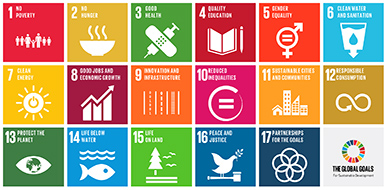 In September 2015, the
2030 Agenda for Sustainable Development was agreed at the United Nations Sustainable Development Summit. This new framework for international cooperation to promote sustainable development between 2015 and 2030 is composed of 17 new Sustainable Development Goals (SDGs) and 169 Targets. The new agenda, which succeeds the
Millennium Development Goals (MDGs), was defined through a Member State-led process with broad
participation from major groups and civil society stakeholders.
In September 2015, the
2030 Agenda for Sustainable Development was agreed at the United Nations Sustainable Development Summit. This new framework for international cooperation to promote sustainable development between 2015 and 2030 is composed of 17 new Sustainable Development Goals (SDGs) and 169 Targets. The new agenda, which succeeds the
Millennium Development Goals (MDGs), was defined through a Member State-led process with broad
participation from major groups and civil society stakeholders.
In
March 2015, at its 46th session, the United Nations Statistical Commission (UNSC) created an
Inter-agency and Expert Group on SDGs (IAEG-SDGs),
composed of Member States and including regional and international agencies as observers, to provide a
proposal of a global indicator framework (and associated global and universal indicators).
In March 2016, at its at its 47th session, the UNSC agreed on the
global indicator framework, which will help monitor progress, identify challenges, and guide policy makers. The data for the 132 indicators included in this framework will be an essential part in the ambitious plan to eliminate poverty and hunger, protect the planet, combat inequalities and build peaceful, just and inclusive societies over the next 15 years. The data will also provide the basis for an annual UN progress report. The Commission agreed that this framework woudl be a practical starting point and that the indicators included in the framework would require further technical refinements.
ICTs and the SDGs
While none of the SDGs is specifically about ICTs, several targets make references to ICTs and technology. The 2030 Agenda for Sustainable Development also recognizes that “The spread of information and communication technology and global interconnectedness has great potential to accelerate human progress, to bridge the digital divide and to develop knowledge societies". ITU has made a concerted effort to highlight the role that ICTs will play in achieving the SDGs. It is actively participating in the discussions on the indicators that will be used to track the SDGs:
- ITU participated in the
Expert Group Meeting on the indicator framework for the post-2015 development agenda, which took place in February, 2015, in New York. As part of its work within the
Partnership on Measuring ICT for Development, it submitted a
joint proposal of ICT indicators to help track the Sustainable Development Goals and targets (pdf format).
- ITU participated in the First Meeting of the Inter-agency and Expert Group on Sustainable Development Goal Indicators (IAEG-SDGs), which took place from 1-2 June 2015, in New York. The IAEG-SDGs was set up by the UN Statistical Commission and is the main group that is in charge of developing the SDG indicators framework. As an input to its first meeting, ITU proposed a list of
8 ICT indicators, covering 8 targets within Goals 1, 4, 5, 9, 16, 17 (pdf format) and
technical/metadata information sheets on these proposed indicators (pdf format).
The
Global SDG Indicator Framework includes the following 7 ICT indicators covering 6 targets under Goals 4, 5, 9, and 17. (The organisation indicated in brackets tracks the indicator at the international level).
- Target 4a: Proportion of schools with access to the Internet for pedagogical purposes (UIS)
- Target 4a: Proportion of schools with access to computers for pedagogical purposes (UIS)
- Target 4.4: Proportion of youth/adults with ICT skills, by type of skills (ITU)
- Target 5b: Proportion of individuals who own a mobile telephone, by sex (ITU)
- Target 9c: Percentage of the population covered by a mobile network, broken down by technology (ITU)
- Target 17.6: Fixed Internet broadband subscriptions, broken down by speed (ITU)
- Target 17.8: Proportion of individuals using the Internet (ITU)
> More